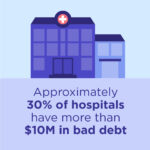Article
Financial fault lines we’re fixing in 2024
It’s been nearly four years since COVID-19 hit the U.S., and as more time passes, we can observe longer-term ripple effects of the pandemic. From growing acceptance of telehealth to public health pushes for vaccinations, influence over clinical aspects of healthcare remains apparent.
Similarly, the business side of healthcare has shifted, and pressures multiplied by the pandemic still linger. Healthcare organizations’ financial metrics have painted a pretty bleak picture for years, and there aren’t many signs pointing toward large improvements.
Here are some of the top challenges Altera Digital Health and our clients are managing in the revenue cycle to move back into the black.
Moving margins
 While 2023 was not as financially tough as 2022, hospitals’ average operating margins in the first seven months of 2023 were still 7% lower than the same period in 2020. This threatens healthcare organizations’ ability to invest in new service lines, if not remain afloat altogether. In fact, nearly one-third of rural hospitals are at risk of closure.
While 2023 was not as financially tough as 2022, hospitals’ average operating margins in the first seven months of 2023 were still 7% lower than the same period in 2020. This threatens healthcare organizations’ ability to invest in new service lines, if not remain afloat altogether. In fact, nearly one-third of rural hospitals are at risk of closure.
From rising supply and pharmaceutical costs to declining reimbursements, many market forces are beyond the control of any individual hospital or practice. Therefore, healthcare organizations must look for what they can change to improve their financial performance. Definitive Healthcare data indicates approximately 30% of hospitals have more than $10 million in bad debt. This suggests an opportunity to improve margins by homing in on aging accounts receivable (A/R).
Stretched staffing
Provider staffing shortages receive a lot of attention (and deservedly so), but shortages of business office staff are just as real and are detrimental to administrative functions. While hiring within the revenue cycle office is already challenging, it will only worsen as the labor market tightens.
The Bureau of Labor Statistics projects that demand for medical/health service managers and medical records specialists will grow faster than average through 2032, by 28% and 8%, respectively. Roles that practice leaders find most difficult to fill include medical coders and billers, according to one MGMA poll. Moreover, when staff members are hired, they often deal with a learning curve as they familiarize themselves with new RCM software.
Resolving longstanding issues
At Altera, we’re always exploring ways we can further support our clients facing these issues. Our technology automates the appeals process, putting the onus on payers to determine why they rejected claims—and tackle aging A/R. We’re also equipped to deploy associates to fill in gaps and complement clients’ internal RCM offices.
Learn more about Altera’s revenue cycle management solutions here.














